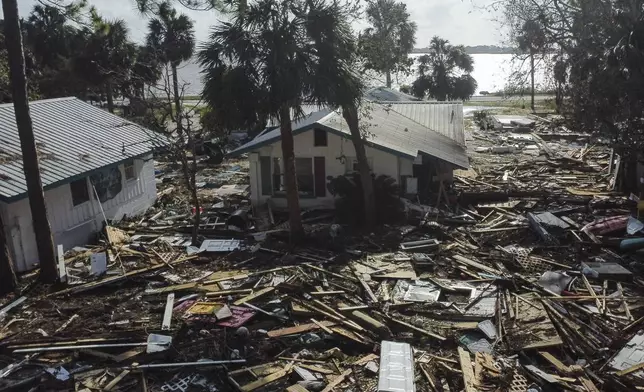Hurricanes are humanity’s reminder of the uncontrollable, chaotic power of Earth’s weather.
Milton’s powerful push toward Florida just days after Helene devastated large parts of the Southeast likely has some in the region wondering if they are being targeted. In some corners of the internet, Helene has already sparked conspiracy theories and disinformation suggesting the government somehow aimed the hurricane at Republican voters.
Click to Gallery
FILE - Dustin Holmes, second from right, holds hands with his girlfriend, Hailey Morgan, while returning to their flooded home with her children Aria Skye Hall, 7, right, and Kyle Ross, 4, in the aftermath of Hurricane Helene, Sept. 27, 2024, in Crystal River, Fla. (AP Photo/Phelan M. Ebenhack, File)
FILE - Residents are rescued from floodwaters in the aftermath of Hurricane Helene, Sept. 27, 2024 in Crystal River, Fla. (Luis Santana/Tampa Bay Times via AP, File)
FILE - Carver Cammans installs cloud seeding equipment, Dec. 3, 2022, in Lyons, Colo. (AP Photo/Brittany Peterson, File)
FILE - Debris surrounds the Faraway Inn Cottages and Motel in the aftermath of Hurricane Helene, in Cedar Key, Fla., Sept. 27, 2024. (AP Photo/Stephen Smith, File)
FILE - A partially submerged vehicle sits in floodwater from after Hurricane Helene passed the area, Sept 27, 2024, in Atlanta. (AP Photo/Jason Allen, File)
FILE - A damaged 100-year-old home is seen after an Oak tree landed on it after Hurricane Helene moved through the area, Sept. 27, 2024, in Valdosta, Ga. (AP Photo/Mike Stewart, File)
FILE - Dustin Holmes, second from right, holds hands with his girlfriend, Hailey Morgan, while returning to their flooded home with her children Aria Skye Hall, 7, right, and Kyle Ross, 4, in the aftermath of Hurricane Helene, Sept. 27, 2024, in Crystal River, Fla. (AP Photo/Phelan M. Ebenhack, File)
Besides discounting common sense, such theories disregard weather history that shows the hurricanes are hitting many of the same areas they have for centuries. They also presume an ability for humans to quickly reshape the weather far beyond relatively puny efforts such as cloud-seeding.
“If meteorologists could stop hurricanes, we would stop hurricanes,” said Kristen Corbosiero, a professor of atmospheric and environmental sciences at the University at Albany. “If we could control the weather, we would not want the kind of death and destruction that’s happened.”
Here’s a look at what humans can and can’t do when it comes to weather:
A fully developed hurricane releases heat energy that is the equivalent of a 10-megaton nuclear bomb every 20 minutes — more than all the energy used at a given time by humanity, according to National Hurricane Center tropical analysis chief Chris Landsea.
And scientists are now finding many ways climate change is making hurricanes worse, with warmer oceans that add energy and more water in the warming atmosphere to fall as rain, said Chris Field, director of the Stanford Woods Institute for the Environment.
“The amount of energy a hurricane generates is insane,” said Colorado State University hurricane researcher Phil Klotzbach. It’s the height of human arrogance to think people have the power to change them, he said.
But that hasn't stopped people from trying, or at least thinking about trying.
Jim Fleming of Colby College has studied historical efforts to control the weather and thinks humans have nowhere near the practical technology to get there. He described an attempt in 1947 in which General Electric partnered with the U.S. military to drop dry ice from Air Force planes into the path of a hurricane in an attempt to weaken it. It didn't work.
“The typical science goes like understanding, prediction and then possibly control,” Fleming said, noting that the atmosphere is far more powerful and complex than most proposals to control it. “It goes back into Greek mythology to think you can control the powers of the heavens, but also it's a failed idea.”
In the 1960s, 1970s and 1980s, the federal government briefly tried Project STORMFURY. The idea was to seed a hurricane to replace its eyewall with a larger one that would make the storm bigger in size but weaker in intensity. Tests were inconclusive and researchers realized if they made the storm larger, people who wouldn’t have been hurt by the storm would now be in danger, which is an ethical and liability problem, the project director once said.
For decades, the National Hurricane Center and its parent agency, the National Oceanic and Atmospheric Administration, have been asked about nuclear-bombing a hurricane. But the bombs aren't powerful enough, and it would add the problem of radioactive fallout, Corbosiero said.
Bringing cooling icebergs or seeding or adding water-absorbing substances also are ideas that just don’t work, NOAA scientists said.
Failed historical attempts to control hurricanes differ somewhat from some scientists' futuristic ideas to combat climate change and extreme weather. That's because instead of targeting individual weather events, modern geoengineers would operate on a larger scale — thinking about how to reverse the broad-scale damage humans have already done to the global climate by emitting greenhouse gases.
Scientists in the field say one of the most promising ideas they see based on computer models is solar geoengineering. The method would involve lofting aerosol particles into the upper atmosphere to bounce a tiny bit of sunlight back into space, cooling the planet slightly.
Supporters acknowledge the risks and challenges. But it also "might have quite large benefits, especially for the world’s poorest," said David Keith, a professor at the University of Chicago and founding faculty director of the Climate Systems Engineering Initiative.
Two years ago, the largest society of scientists who work on climate issues, the American Geophysical Union, announced it was forming an ethics framework for “climate intervention."
Some scientists warn that tinkering with Earth’s atmosphere to fix climate change is likely to create cascading new problems. University of Pennsylvania climate scientist Michael Mann expressed worries on the ethics framework that just talking about guidelines will make the tinkering more likely to occur in the real world, something that could have harmful side effects.
Field, of Stanford, agreed that the modeling strongly encourages that geoengineering could be effective, including at mitigating the worst threats of hurricanes, even if that's decades away. But he emphasized that it's just one piece of the best solution, which is to stop climate change by cutting greenhouse gas emissions.
“Whatever else we do, that needs to be the core set of activities,” he said.
This story has corrected Michael Mann's affiliation to the University of Pennsylvania, not Penn State.
Follow Melina Walling on X: @MelinaWalling.
The Associated Press’ climate and environmental coverage receives financial support from multiple private foundations. AP is solely responsible for all content. Find AP’s standards for working with philanthropies, a list of supporters and funded coverage areas at AP.org.

FILE - Residents are rescued from floodwaters in the aftermath of Hurricane Helene, Sept. 27, 2024 in Crystal River, Fla. (Luis Santana/Tampa Bay Times via AP, File)

FILE - Carver Cammans installs cloud seeding equipment, Dec. 3, 2022, in Lyons, Colo. (AP Photo/Brittany Peterson, File)

FILE - Debris surrounds the Faraway Inn Cottages and Motel in the aftermath of Hurricane Helene, in Cedar Key, Fla., Sept. 27, 2024. (AP Photo/Stephen Smith, File)

FILE - A partially submerged vehicle sits in floodwater from after Hurricane Helene passed the area, Sept 27, 2024, in Atlanta. (AP Photo/Jason Allen, File)

FILE - A damaged 100-year-old home is seen after an Oak tree landed on it after Hurricane Helene moved through the area, Sept. 27, 2024, in Valdosta, Ga. (AP Photo/Mike Stewart, File)

FILE - Dustin Holmes, second from right, holds hands with his girlfriend, Hailey Morgan, while returning to their flooded home with her children Aria Skye Hall, 7, right, and Kyle Ross, 4, in the aftermath of Hurricane Helene, Sept. 27, 2024, in Crystal River, Fla. (AP Photo/Phelan M. Ebenhack, File)
LONDON (AP) — A car-ramming at a Christmas market in Germany, which police are treating as an attack, is the latest in a grim series of events in which vehicles have been used as deadly weapons.
There have been a spate of such attacks over the past decade, some committed by groups but most by individuals. The motives – where they could be established – have varied widely. Some were inspired by Islamic militant groups such as al-Qaida and ISIS, which encouraged followers to carry out low-cost, low-tech attacks with cars and trucks. Others have been linked to mental illness, far-right extremism and online misogyny.
What law-enforcement authorities term “vehicle as a weapon attacks” have reshaped cities around the world, as planners erect concrete barriers around public spaces and build anti-vehicle obstacles into new developments.
Here are some major vehicle attacks:
MAGDEBURG, Germany, Dec. 20. 2024 — At least five people are killed and more than 200 injured when a car slams into a Christmas market in eastern Germany. The suspect, who was arrested, is a 50-year-old doctor originally from Saudi Arabia who had expressed anti-Muslim views and support for the far-right AFD party.
ZHUHAI, China, Nov. 11, 2024 — A 62-year-old driver rams his car into people exercising at a sports complex in southern China, killing 35 people in the country’s deadliest mass slaying in years. Authorities said the perpetrator was upset about his divorce but offered few other details.
LONDON, Ontario, June 6, 2021 — Four members of a Muslim family die when an attacker hits them with a pickup truck while they are out for a walk, in what Canadian Prime Minister Justin Trudeau calls “a terrorist attack, motivated by hatred.” White nationalist attacker Nathaniel Veltman was sentenced to life in prison.
TORONTO, April 23, 2018 — A 25-year-old Canadian man, Alek Minassian, drives a rented van into mostly female pedestrians on Yonge St., the main thoroughfare in Toronto, killing 10 people and injuring 16. Minassian told police he belonged to the online “incel” community of sexually frustrated men.
NEW YORK, Oct. 31, 2017 — Sayfullo Saipov, an Islamic extremist from Uzbekistan, drives a pickup truck onto a popular New York City bike path, killing eight.
BARCELONA, Aug. 17, 2017 — A man driving a van slams into people on the Spanish city’s crowded Las Ramblas boulevard, killing 14 and injuring many others. Several members of the same cell carry out a similar vehicle attack in the nearby resort town of Cambrils before they are shot dead by police. The Islamic State group claimed responsibility.
CHARLOTTESVILLE, Virginia, Aug. 12, 2017 — During a “Unite the Right” rally, white supremacist James Alex Fields Jr. intentionally drives his car into a crowd of counter-protesters, killing one woman and injuring dozens of people.
LONDON: March 22, 2017 — British man Khalid Masood rams an SUV into people on Westminster Bridge, killing four, before stabbing to death a policeman guarding the Houses of Parliament nearby. He is shot dead. June 3, 2017 — three attackers drive a van at pedestrians on London Bridge before stabbing people in nearby Borough Market. Eight people are killed and the attackers shot dead by police. June 19, 2017 — Darren Osborne, a man radicalized by far-right ideas, drives a van at worshippers outside a mosque in London’s Finsbury Park area, killing one man and injuring 15 people.
MELBOURNE, Australia, Jan 20, 2017 – Six people are killed and more than 30 injured when a car hits lunchtime crowds at a pedestrian mall in Australia’s second-largest city. Perpetrator James Gargasoulas is found to have been in a state of drug-induced psychosis.
BERLIN, December 19, 2016 — Anis Amri, a rejected asylum-seeker from Tunisia, plows a hijacked truck into a Christmas market in the German capital, killing 13 people and injuring dozens. The attacker is killed days later in a shootout in Italy.
NICE, France, July 14, 2016 — Tunisian-born French resident Mohamed Lahouaiej-Bouhlel drives a rented truck for more than a mile (almost 2 kilometers) along a packed seaside promenade in the French Riviera resort on the Bastille Day holiday, killing 86 people in the deadliest attack of its kind.
APELDOORN, Netherlands, April 28, 2009 – Former security guard Karst Tates drives a car into parade spectators in an attempt to hit an open-topped bus carrying members of the Dutch royal family. Six people are killed and Tates dies of injuries the next day, leaving his full motive a mystery.
CHAPEL HILL, North Carolina, March 3, 2006 — University of North Carolina graduate Mohammed Taheri-Azar drives an SUV into a crowd at the university, lightly injuring nine people, in a self-professed bid to avenge Muslim deaths overseas.

FILE - Injured people are treated in Barcelona, Spain, Thursday, Aug. 17, 2017 after a white van jumped the sidewalk in the historic Las Ramblas district, crashing into a summer crowd of residents and tourists. (AP Photo/Oriol Duran, File)

FILE - In this April 23, 2018, file photo, police stand near a damaged van after a van mounted a sidewalk crashing into pedestrians in Toronto. (Aaron Vincent Elkaim/The Canadian Press via AP, File)

FILE - Forensic officers move the van at Finsbury Park in north London, where a vehicle struck pedestrians in north London Monday, June 19, 2017. (AP Photo/Frank Augstein, File)

FILE - In this Dec. 20, 2016 file photo the trailer of a truck stands beside destroyed Christmas market huts in Berlin, Germany. (AP Photo/Markus Schreiber, file)

FILE - In this July 14, 2016 file photo, authorities investigate a truck after it plowed through Bastille Day revelers in the French resort city of Nice, France, killing 86 people. (Sasha Goldsmith via AP, File)

FILE - In this Wednesday, March 22, 2017 file photo, police secure the area on the south side of Westminster Bridge close to the Houses of Parliament in London. (AP Photo/Matt Dunham, File)

FILE - People fly into the air as a vehicle drives into a group of protesters demonstrating against a white nationalist rally in Charlottesville, Va., Saturday, Aug. 12, 2017. (Ryan M. Kelly/The Daily Progress via AP, File)

FILE - In this Dec. 20, 2016 file photo Christmas decoration sticks in the smashed window of the cabin of a truck which ran into a crowded Christmas market Monday evening killing several people in Berlin, Germany. (AP Photo/Markus Schreiber, file)





























